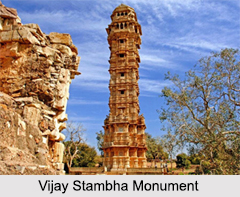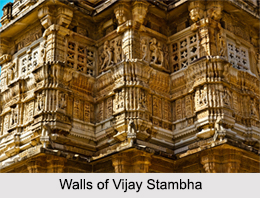 Mewar King Rana Kumbha constructed Vijay Stambha or "Tower of Victory†is a sight located at Chittorgarh in Rajasthan. It has attracted attention of tourists since a long time. It is one of the most known historical monument of India famous for its architecture and stand alone structure.
Mewar King Rana Kumbha constructed Vijay Stambha or "Tower of Victory†is a sight located at Chittorgarh in Rajasthan. It has attracted attention of tourists since a long time. It is one of the most known historical monument of India famous for its architecture and stand alone structure.
History of Vijay Stambha
It was built between 1442 AD and 1449 AD to memorialize his victory over the collective armies of Malwa and Gujarat that was led by Mahmud Khilji. Vijay Stambha is an imposing structure located in Chittorgarh Fort in India. The architecture of Vijay Stambha is dedicated to Lord Vishnu. This monument is 37.19 meters high and is a 9-storied tower that is marked as one of the most remarkable in India.
Architecture of Vijay Stambha
Vijay Stambha is built in amalgamation of red sand stone and white marble stone and is enriched by numerous images of Hindu Gods and goddesses with inscriptions at bottom of each. It is believed that the tower took 10 years to get completed. This excellent piece of architecture stands on an elegant pedestal, 10 feet high.
 Each of the nine stories of Vijay Stambha is distinctly marked with openings and balconies at every facade of each storey. The interior staircase winds round alternately through the central chamber and neighbouring gallery. The inscribed slabs in the uppermost story contain the lineage of the rulers of Chittor from Hamir to Rana Kumbha. The entire Vijay Stambha is covered with architectural ornaments and inscribed images of Gods and goddesses, symbols of seasons, weapons, musical instruments and others. Its inscribed sculpture is a veritable textbook of Hindu iconography.The Vijaya Stambha is a remarkable example of religious pluralism practised by the Rajputs. The topmost storey features an image of the Jain Goddess, Padmavati.
Each of the nine stories of Vijay Stambha is distinctly marked with openings and balconies at every facade of each storey. The interior staircase winds round alternately through the central chamber and neighbouring gallery. The inscribed slabs in the uppermost story contain the lineage of the rulers of Chittor from Hamir to Rana Kumbha. The entire Vijay Stambha is covered with architectural ornaments and inscribed images of Gods and goddesses, symbols of seasons, weapons, musical instruments and others. Its inscribed sculpture is a veritable textbook of Hindu iconography.The Vijaya Stambha is a remarkable example of religious pluralism practised by the Rajputs. The topmost storey features an image of the Jain Goddess, Padmavati.
The portraits of the architect of Vijay Stambha, namely the Jaita and his 3 sons, Napa, Puja and Poma are carved beautifully on the fifth floor of the tower. There are around 157 narrow steps ascending towards the terrace from where one can enjoy a beautiful view of Chittorgarh town and the fort. The uppermost floor is sealed off and is no longer reachable to visitor.



















